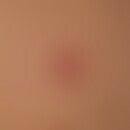EtiopathogenesisThis section has been translated automatically.
Cardiofaciocutaneous (CFC) syndrome is inherited in an autosomal dominant manner. Most affected individuals have CFC as a result of a de novo pathogenic variant. The offspring of an affected individual have a 50% risk of inheriting a CFC-related pathogenic variant. Prenatal testing for high-risk pregnancies is available if the pathogenic BRAF, MAP2K1, MAP2K2, or KRAS variant has been identified in an affected family member.
DiagnosisThis section has been translated automatically.
You might also be interested in
TherapyThis section has been translated automatically.
Treatment of manifestations: Care by a multidisciplinary team; treatment of cardiac structural defects, hypertrophic cardiomyopathy, and cardiac arrhythmias as in the general population; increased humidity or moisturizing lotions for xerosis and pruritus; increased caloric intake and a nasogastric tube or gastrostomy for severe feeding problems; surgical intervention for severe gastroesophageal reflux; routine treatment of growth hormone deficiency, ocular abnormalities; treatment of seizures may require polytherapy; occupational therapy, physical therapy, and speech therapy as needed. Consensus guidelines for medical management have been published.
ProphylaxisThis section has been translated automatically.
Antibiotic prophylaxis for subacute bacterial endocarditis, especially in patients with valvular malformations; screening for hypertrophic cardiomyopathy or predisposition to arrhythmias before anesthesia.
LiteratureThis section has been translated automatically.
- Rauen KA (2016) Cardiofaciocutaneous syndrome. In: Adam MP, Mirzaa GM et al. editors. GeneReviews [Internet]. Seattle (WA): University of Washington, Seattle 1993-2022.
Disclaimer
Please ask your physician for a reliable diagnosis. This website is only meant as a reference.




